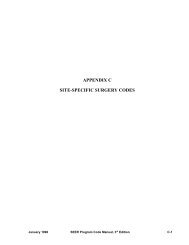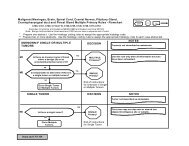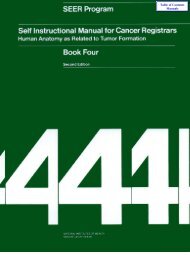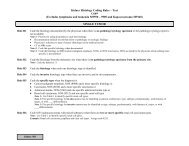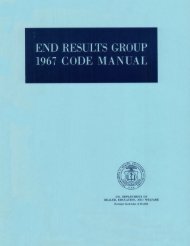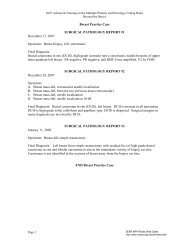Self Instructional Manual for Cancer Registrars - SEER - National ...
Self Instructional Manual for Cancer Registrars - SEER - National ...
Self Instructional Manual for Cancer Registrars - SEER - National ...
You also want an ePaper? Increase the reach of your titles
YUMPU automatically turns print PDFs into web optimized ePapers that Google loves.
SECTION<br />
C<br />
ABSTRACTING THE MEDICAL RECORD: WHAT, WHEN, AND HOW TO ABSTRACT<br />
WHAT CASES TO ABSTRACT<br />
A separate abstract is generally prepared <strong>for</strong> each independent cancer. Specific rules may modify that<br />
general rule <strong>for</strong> selected sites. For example, in the <strong>SEER</strong> Program multiple neoplasms of the urinary bladder<br />
are represented by a single summary abstract since multiple tumors so frequently occur in this site. Skin<br />
cancers are also handled in this manner. However, <strong>for</strong> most multiple primary tumors, each unrelated<br />
malignancy is abstracted on a separate <strong>for</strong>m. The registry number <strong>for</strong> patients with multiple primary tumors<br />
usually remains the same; a higher sequence number is assigned <strong>for</strong> each new primary cancer. Sequence<br />
number indicates the order in which a primary tumor is discovered in relation to the total number of<br />
primaries <strong>for</strong> a given patient. For example, the sequence number <strong>for</strong> the first of two primaries is 1; the<br />
sequence number <strong>for</strong> the second of two primaries is 2. Each primary is recorded on a separate abstract.<br />
Hospitals with cancer programs approved by the Commission on <strong>Cancer</strong> of the American College of<br />
Surgeons are required to register all carcinomasr sarcomas, melanomas, leukemias, and lymphomas, all<br />
malignancies with a behavior code of 2 or higher in the International Classification of Diseases <strong>for</strong> Oncolog),,<br />
Second Edition, (ICD-O-2).<br />
Inconclusive<br />
diagnosis<br />
When the diagnosis is vague or inconclusive, such as probable carcinoma of the lung, the following terms<br />
indicate involvement:<br />
compatible with suspect consistent with<br />
suspicious probable most likely<br />
The following terms are not to be interpreted as involvement:<br />
equivocal suggests possible<br />
worrisome<br />
questionable<br />
For example, a diagnosis of probable carcinoma of the left lung would be abstracted as a lung primary. A<br />
diagnosis of questionable carcinoma of the left lung with brain metastasis would be abstracted as an unknown<br />
primary. A possible carcinoma is not reportable.<br />
Changing<br />
the diagnosis<br />
Over time, in<strong>for</strong>mation may be added to the patient's medical chart that was missing in the original record.<br />
There<strong>for</strong>e, it is the practice to accept the thinking and in<strong>for</strong>mation about the case based on the latest or most<br />
complete in<strong>for</strong>mation. Thus, it is acceptable to change the primary site, histology, and extent of disease as<br />
in<strong>for</strong>mation becomes more complete.<br />
Benign tumors and borderline malignancies (behavior codes 0 and 1) also may be listed in the registry.<br />
These diagnoses are referred to as "reportable-by-agreement" cases.<br />
15




